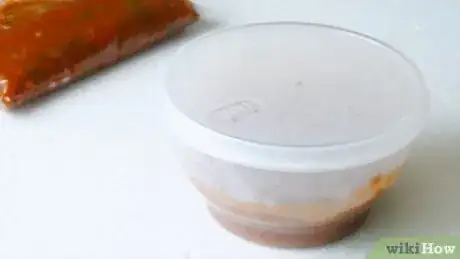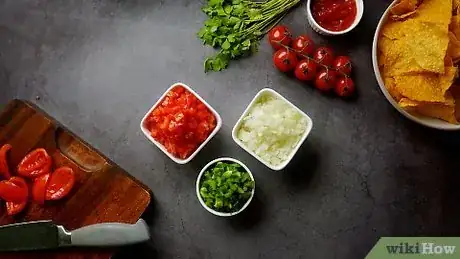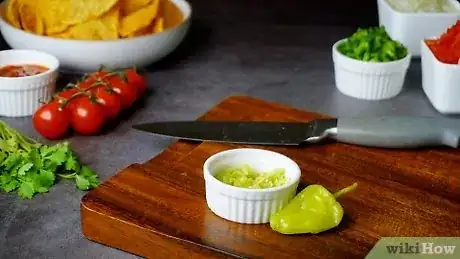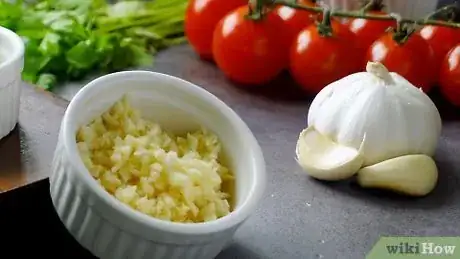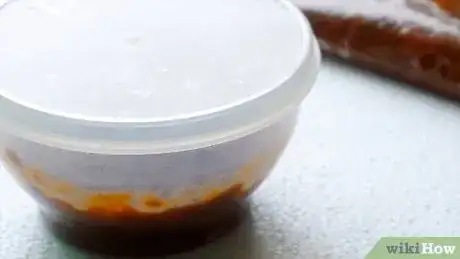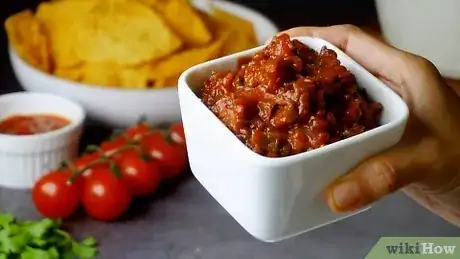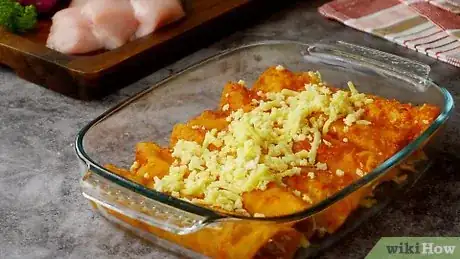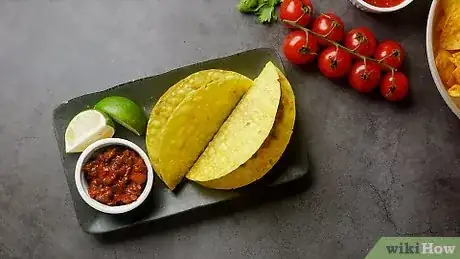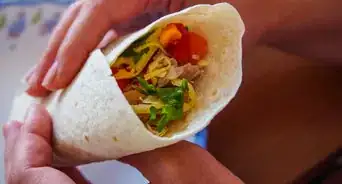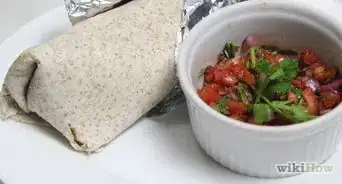This article was co-authored by Marrow Private Chefs and by wikiHow staff writer, Hunter Rising. Marrow Private Chefs are based in Santa Rosa Beach, Florida. It is a chefs’ collaborative comprised of an ever-growing number of chefs and culinary professionals. Though regionally influenced primarily by coastal, traditional southern, cajun, and creole styles and flavors, the chefs at Marrow have a solid background in all types of cuisine with over 75 years of combined cooking experience.
There are 9 references cited in this article, which can be found at the bottom of the page.
This article has been viewed 51,622 times.
Salsa is a great dip and condiment that can be served on its own or cooked into a meal. Whether it’s store-bought or homemade, you can preserve salsa in the freezer easily. Once you thaw the salsa, drain any excess water and add it to your recipes to make them pop!
Ingredients
Makes 10 cups (2,400 mL)
- 10 to 15 ripe tomatoes
- 2 large onions
- 8 cloves of garlic
- 8 jalapeno peppers
- 2 green peppers
- ½ cup (25 g) of chopped cilantro
- 1⁄4 cup (59 ml) of lime juice or cider vinegar
- 3 tsp (7.8 g) of ground cumin
- 1 tsp (2.6 g) of ground coriander
- 2 tsp (8 g) of granulated sugar
- 2 tsp (10 g) of salt
- ½ tsp (1.3 g) of cayenne pepper
- 1 tsp (2.6 g) of black pepper
Steps
Storing Ready-Made Salsa
-
1Simmer out the excess liquid to thicken it without changing the flavor. Pour the salsa into a saucepan and keep it over a medium-low heat until half of the liquid has evaporated, which should take around 45 minutes. Thicker salsa will freeze best. This process works with store-bought or homemade salsa.[1]
- If you’ve purchased thick and chunky salsa, you can skip this step or reduce less of the liquid.
-
2Let the salsa cool to room temperature. Take the salsa off the heat and let it cool at room temperature before you transfer it into the freezer, which should take around 1 hour. Cover the pot with a vented lid so heat escapes.[2]
- If you freeze salsa before it is cooled, the condensation will freeze and form ice at the top of your container.
Advertisement -
3Add one 6 oz (170 g) can of tomato paste to thicken the salsa quickly. Use tomato paste at room temperature if you don’t have the time to simmer the salsa down or you want it to have a thicker consistency. Use 1 can per 10 cups (80 fl oz) of salsa.[3]
- For an even thicker salsa, put in an additional 6 ounces (170 g) of tomato paste into the salsa.
-
4Put the salsa in freezer-safe containers. Store the salsa in airtight plastic or glass containers, or store it in freezer bags. After the salsa cools, pour the salsa so there is 3⁄4 inch (19 mm) of space left at the top of the container so it has room to expand when it freezes.
- To save space or to make single portions of salsa, use freezer-safe sandwich bags and stack them in your freezer. Make sure you remove all the air from the bag before you seal it.
- Freeze your salsa in 1 c (240 mL) portions if you plan to use it frequently. That way, you don’t have to thaw all your salsa each time.
-
5Store the salsa in the freezer for up to 4 months. When you put your salsa in the freezer, label it with the date so you know how long it’s good for. Include if the salsa is mild or spicy if you have several varieties.[4]
Making Freezer Salsa
-
1Cut 10-15 tomatoes into 4 quarters and remove the seeds. Use a sharp knife to cut each tomato in half, and then cut each half in half. Lay one of the quarters so the rounded side is on the cutting board. Run your blade as close to the outer flesh of the tomato as possible to cut out the seeds and core of each tomato.[5]
-
2Chop the tomatoes, onions, and green peppers into cubes. You'll need 2 large onions and 2 green peppers. The thickness each cube will depend on how chunky you want the salsa to be once it’s finished.[6]
-
3Chop 8 jalapeno peppers finely. Cut the jalapenos into smaller cubes that the rest of the ingredients. These peppers have a more intense flavor that could be overwhelming in large quantities.[7]
- The seeds of the jalapeno hold the most heat. Leave the seeds in for a spicier salsa or remove them for a milder flavor.
- Do not touch your eyes after handling the peppers.
- Substitute any hot pepper instead of jalapenos for a milder or spicier flavor.
-
4Mince 2 cloves of garlic. Smash each clove of garlic underneath your knife blade. Guide the clove under the knife as you chop. Rock the knife back and forth to mince the garlic completely.[8]
- Use a garlic press for each clove if you want to avoid getting the garlic smell on your hands.
-
5Mix all the ingredients in a large pot. Combine the tomato, onion, peppers, and garlic. Add 1/2 cup (25 g) of chopped cilantro, 1/4 cup (59 ml) of lime juice or cider vinegar, 3 tsp (7.8 g) of ground cumin, 1 tsp (2.6 g) of ground coriander, 2 tsp (8 g) of granulated sugar, 2 tsp (10 g) of salt, 1/2 tsp (1.3 g) of cayenne pepper, and 1 tsp (2.6 g) of black pepper. Stir the ingredients with a wooden or plastic spoon.[9]
- If you accidentally make your salsa too spicy, you can always add more tomatoes.
-
6Bring the salsa to a boil over medium heat and stir it thoroughly. Make sure the spices are mixed in entirely so the flavors cook together evenly.[10]
-
7Simmer the salsa for at least 45 minutes. Don’t cover the salsa as it simmers since you want about half of the liquid to evaporate. You can simmer the salsa for longer if you want it to have a thicker consistency.[11]
-
8Let the salsa cool completely before storing it. Take the salsa off the heat and let it cool to room temperature. You’ll be able to tell it’s cooled once it stops steaming and it is cool to the touch.[12]
- Warm salsa will create condensation if it’s frozen and will form ice inside the container.
-
9Store the salsa for 6 months in freezer-safe bags. Fill the bag so there is 1⁄2 inch (13 mm) of empty space at the top so it has room to expand. Store the salsa in 1 c (240 mL) portions so you don’t have to thaw all of the salsa each time you want some. Stack the bags in the freezer.[13]
- Alternatively, store the salsa in an airtight container. You should still leave room at the top for the salsa to expand once it freezes.
- Label the container or bag with the date you made the salsa.
Thawing and Using Frozen Salsa
-
1Thaw the salsa in your fridge for 24 hours before cooking with it. Don’t leave your salsa at room temperature to thaw. Transfer the salsa from the freezer to fridge the day before you plan to use it.[14]
-
2Drain the excess water from the thawed salsa. Water may have formed once the salsa has thawed. If so, carefully pour the excess water into the sink to make your salsa chunkier.[15]
-
3Marinate steak with salsa. Pour the salsa into the same container as the steak. Let it sit at room temperature for 1 hour. As an alternative, marinate the steak for 24 hours in the fridge in a covered container so the flavor fully absorbs into the steak. Grill the meat over medium-high heat until it reaches your desired temperature.[16]
- Steaks need to reach an internal temperature of 145 °F (63 °C) for safe consumption.
-
4Mix salsa into your enchiladas. Heat chicken or beef in a pan until it is cooked through. Put the chicken into tortillas in a 13 by 9 in (33 by 23 cm) pan. Top the chicken with black beans, corn, salsa, enchilada sauce, and cheese. Cook the enchiladas for 20 minutes and top them with cheese and sauce.[17]
-
5Use salsa as a sauce for Mexican pizza. Use either a premade pizza crust or tortillas as the base. Use a spoon to spread the salsa over the crust. Cover the salsa with taco meat, beans, and cheese. Cook the pizza for 15 minutes at 350 °F (177 °C).[18]
- Spread lettuce and diced tomatoes on top of the pizza for a fresh flavor.
- Use leftover salsa as a dip for your pizza.
-
6
Things You’ll Need
- Saucepan
- Stove
- Sharp knife
- Cutting board
- Measuring spoons
- Freezer bags or containers
- Freezer
References
- ↑ http://www.gettystewart.com/how-to-make-freezer-salsa-tomatoes/
- ↑ http://www.gettystewart.com/how-to-make-freezer-salsa-tomatoes/
- ↑ http://www.gettystewart.com/how-to-make-freezer-salsa-tomatoes/
- ↑ https://tastessence.com/can-you-freeze-homemade-salsa
- ↑ https://toriavey.com/how-to/how-to-seed-tomatoes/
- ↑ http://www.gettystewart.com/how-to-make-freezer-salsa-tomatoes/
- ↑ https://www.thekitchn.com/how-to-cut-a-jalapeno-the-right-way-234848
- ↑ http://www.myrecipes.com/how-to/video/peeling-mincing-garlic
- ↑ http://www.gettystewart.com/how-to-make-freezer-salsa-tomatoes/
- ↑ http://www.gettystewart.com/how-to-make-freezer-salsa-tomatoes/
- ↑ http://www.gettystewart.com/how-to-make-freezer-salsa-tomatoes/
- ↑ http://www.gettystewart.com/how-to-make-freezer-salsa-tomatoes/
- ↑ http://www.gettystewart.com/how-to-make-freezer-salsa-tomatoes/
- ↑ https://tastessence.com/can-you-freeze-homemade-salsa
- ↑ http://www.gettystewart.com/how-to-make-freezer-salsa-tomatoes/
- ↑ https://www.lifemadedelicious.ca/recipes/salsa-marinade/816cf3f1-90c3-47df-8dd4-46bd4531dc6e
- ↑ https://www.chocolatemoosey.com/2015/04/30/salsa-chicken-enchiladas/
- ↑ http://www.geniuskitchen.com/recipe/taco-pizza-174145
- ↑ http://www.geniuskitchen.com/recipe/tacos-208542
- ↑ https://tastessence.com/can-you-freeze-homemade-salsa

